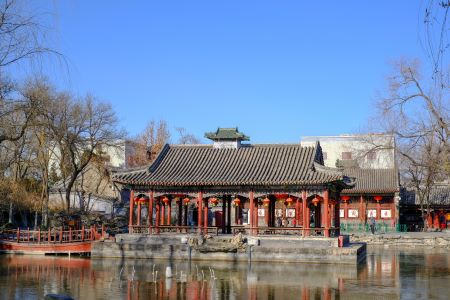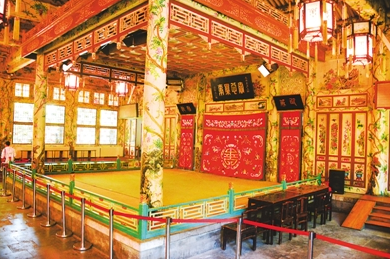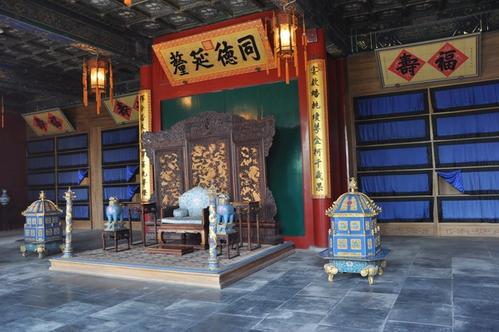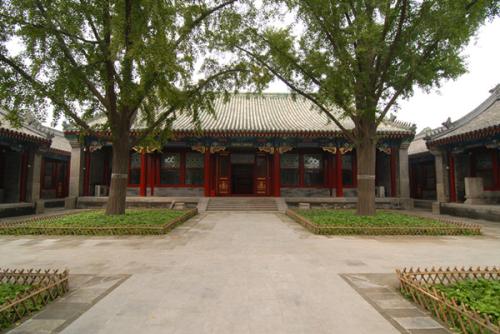Chinese Name: 恭王府 Pronunciation: Gōngwáng Fǔ
Building Time: 1776
Recommended Time for Visit: 2-3 Hours
Occupied Area: 61,120 square meters
Address: No. 17, Qianhai West Street, Xicheng District, Beijing
Best Visiting Season: Spring(From April to May) and Autumn(From September to October)
Building Function: The mansion of important Chinese officials and imperial relatives of the Qing Dynasty (1644-1912)
| Tickets | Peak Season (From March 16th to November 15th) |
Low Season (From November 16th to the March 15th of next year) |
| Admission Fee | 40 yuan | |
| Joint Ticket (including the admission fee, entrance ticket, tour guide, the Grand Theatre Tower, the Palace of Silver Peace, and the Jiale Hall) |
70 yuan | |
1. Seniors aged 60 or above with valid ID card and passport can buy the half-price ticket.
2. Minors aged 7-18 with valid ID card and passport can buy the half-price ticket.
Children under 120cm in height: free of charge.
| Season | Peak Season (March 16th to November 15th) |
Low Season (November 16th to the March 15th of next year) |
| Opening Time | 7:30-16:30 | 9:00-16:00 |

There is a quiet, long, willow-shaded alleyway in the southwest of the Beijing Shichahai. In the alley sits a royal mansion, the most well-preserved of all existing royal mansions, Prince Gong’s Mansion, which was the largest of the Qing Dynasty royal buildings. The mansion was formerly owned by a powerful official He Shen under the Qianlong Emperor’s reign (1735-1795) of the Qing Dynasty, and Yong Lin, the younger brother of Emperor Jiaqing(1760-1820). In 1851, the Qing Court granted the mansion to Prince Gong, Yi Xin, which is the origin of the name Prince Gong’s Mansion.
The mansion is grand and imposing and it is divided into two parts: the residence and the garden, with more than 30 buildings of all kinds. It has witnessed the history of the Qing Dynasty from its peak to its decline, and is of great historical and cultural significance.
In 1776, He Shen, a high-ranking official of the Qing Dynasty, began building a mansion here.
In 1788, the mansion was largely completed.

On February 22, 1799, all of He Shen’s possessions including the mansion were confiscated. Later in 1799, Emperor Jiaqing gave He Shen's residence to his younger brother, Yong Lin.
In 1850, Emperor Xianfeng gave the mansion to his sixth brother, Prince Gong, Yi Xin. Then Yi Xin moved into the mansion, which became known as Prince Gong’s Mansion.
In 1986, the restoration of Prince Gong’s Mansion was basically completed.
On May 18, 2012, the unveiling ceremony of Prince Gong’s Mansion listed as the national AAAAA level tourist attraction was held, and then the mansion was opened officially to the public.

The Grand Theater Tower, built between 1862 and 1874, was a place for Prince Gong and his relatives and friends to watch operas. It is said that although the entire tower was constructed of brick and wood, there was not a single iron nail used. Particularly noteworthy is the sound effect of the tower. To ensure that the sound was realistic, several large vats were placed underneath the stage, and the clever and special structure increased the resonance space so that the audience could clearly hear the actors singing without the use of any sound-transmitting tools anywhere in the tower.
The two pillars on both sides of the stage, the four walls, and the roof are covered with twining vines, giving the audience the feeling of watching a play under a vine. There are 20 large palace lanterns hanging from the ceiling and the ground floor is paved with bricks. The back wall of the theater was made of light brown wood latticework, with dark blue silk cloth as the backing and covering. In addition to the theater, whenever important people in the mansion died, the theater would be covered with elegiac draperies, incense would be burnt, and monks and nuns would chant prayers for the departed.

The Palace of Silver Peace is the main building of Prince Gong’s Mansion. As the main hall of the mansion, it could only be opened when it comes to major events and festivals, playing the role of welcoming guests. The original palace was destroyed in 1912, during the night of the Lantern Festival due to burning incense, and thus the current palace courtyard is a restored one.
The main hall of the palace is roofed with green glazed cylinder tiles, and the roof ridge is covered with green glazed chiwen, an architectural ornament in the shape of animals, while the roof of the ancillary hall is covered with gray cylinder tiles, indicating the status of Prince Gong.

Behind the Palace of Silver Peace is the Jiale Hall, a building that used to be owned by He Shen during his lifetime. The plaque is suspected to have been granted to He Shen by Emperor Qianlong.
During Prince Gong’s stay here, the Jiale Hall was used primarily as a place of sacrifice, with tablets dedicated to Gong’s ancestors, and gods, and was dominated by shamanistic rituals.
Enter from Palace Gate → Palace of Silver Peace → Jiale Hall → Xijin Studio → Back Screen Buildings → Western-style Gate → Bat Pond → Cave of Secret Cloud (Stele of Fu) → Chamber of Mental Purification → Mid-lake Pavilion → Hillside Pavilion of Autumn → Yuguan Pass
Enter from Palace Gate → Palace of Silver Peace → Duofu Hall → Baoguang Chamber → Xijin Studio → Back Screen Buildings → Western-style Gate → Bat Pond → Pavilion of Floating Wine Cups → Grand Theatre Tower → Bat Hall → Moon Appreciation Terrace → Stele of Fu → Chamber of Mental Purification → Mid-lake Pavilion → Yuguan Pass → Hillside Pavilion of Autumn → Temple of Dragon King
Take Bus No. 107, 111, 118, 13, 204 (Outer Loop), 42, 612, 701, or 90 (Outer) and get off at Beihai North Gate Station.
Take Metro Line 6 and get off at Beihai North Station (exit B or northeast exit). After getting out from the exit, you can walk along the Sanzuoqiao Hutong for about 200 meters or along the Longtoujing Street for about 300 meters, then you can see the Prince Gong’s Mansion.
Chinese: 请带我去恭王府。English: Please take me to Prince Gong’s Mansion.
If you go to the Main Gate of Prince Gong’s Mansion from the center of Beijing (Grand Hyatt Beijing), it takes about 25 minutes (about 20 yuan).
If you go to the Main Gate of Prince Gong’s Mansion from Beijing Capital International Airport, it takes about 1 hour (about 75 yuan).
If you go to the Main Gate of Prince Gong’s Mansion from Beijing Daxing International Airport, it takes about 1 hour and 30 minutes (about 180 yuan).
If you go to the Main Gate of Prince Gong’s Mansion from Beijing West Train Station, it takes about 30 minutes (about 30 yuan).
